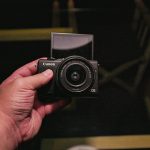Perhaps you’re using an older Canon DSLR, like the 77D, and you’re thinking of upgrading. Maybe you’ve heard about Canon’s legendary Autofocus, and you want to switch from a different brand. Or maybe you’ve read my Canon R5 review, and you’ve decided that you don’t need all of its specs. If you’re considering Canon’s first mirrorless full-frame camera, the Canon EOS R, in this article I’m going to go over who should buy it, and who shouldn’t.
By the way, as a quick note, the B-roll of the Canon EOS R has been shot with the Canon R5, but I’ll include some photos and videos taken with the EOS R throughout the article.
The R5 footage was shot in 1080p, at 120 frames per second, with Canon Log active, and the footage was later rendered in 4K. I explain later in this article why the video itself is 4K, despite the footage being 1080p.

Size & Build
As always, let’s star with the size and build. The Canon EOS R measures 136 x 98 x 84mm, and weighs 660g with battery, and SD card.
In terms of ergonomics, the camera feels great in the hand, and the body feels well built. As a quick note, the camera is not small, especially once you get some RF glass on there.
Once you do get the camera in your hands, the first thing you’re going to notice is the M-Fn Bar, which some might liken to the MacBook Touch Bar.
Unfortunately, I ended up using the M-Fn Bar as much as I use the Touch Bar on my MacBook, which is never. The Bar can be customised though, to either act as two buttons, or as a swipe-able control surface.

Image Quality
In terms of image quality, the EOS R offers the same sensor that you get in the 2016 EOS 5D Mark IV, and you get 30 Megapixels.
You don’t get any in-body image stabilisation, so even with a stabilised RF lens, it can be difficult to get stabilised handheld footage. A workaround for this is to shoot everything in slow motion, which is what I do, but this is not practical in all scenarios.
For example, when I shot the footage for my Canon R5 review, on the EOS R, it was all shot handheld at 60 fps, with a 15-35mm RF lens, which is stabilised. I then slowed it down in Premiere to 40%, which brought the footage to 24 fps, but I quickly realised that wasn’t quite enough.
I then decided to slow it down to 20% of its original speed, which is 12 fps, and I used Optical Flow in Premiere, to fill in the missing frames, so that the footage still looked fluid.
The results were satisfactory, though you sometimes get some glitches from Optical Flow, especially when text is on screen.
This can work when shooting B-roll, especially if you move the camera slowly like I do, but I am well aware that this would not work for everyone.

Now, you can use digital stabilisation in-camera, but it’s not worth it. Once you turn on the digital IS, it’ll be baked into the footage. The advantage of shooting without is that you can tinker more with it in Premiere later, and as technology advances, you’ll get better stabilisation in the future.
In terms of video modes, this camera does do 4K at 30 frames per second, but with a 1.8x crop. Dual Pixel AF is available when shooting 4K, which is great, but the 1.8x crop still applies, which makes it difficult to shoot wide-angle footage.
At least the Auto Focus performs well in low light, and you get great eye detection.
In terms of 1080p, you can shoot at 60 fps. Even though some might turn their nose at 1080p, the video above was shot in 1080p, and then rendered in 4K. I’ll go into a bit more detail about this in a little while.
As a last note in regards to the vide modes, you can also shoot in 720p at 120fps, and this may not be as useless as you might think. Under the right lighting conditions, with the right settings, you would be able to pass it as 1080p no problem.
As I mentioned earlier, the video above was shot in 1080p, and rendered in 4K. The reason is that if you render it as such, YouTube compression will allow more of the 1080p detail to show through, as opposed to just rendering in 1080p.
Given that you probably didn’t realise this is actually 1080p you’re looking at, people may not realise they’re looking at 720p.
Matti Haapoja made a video on the topic, showcasing footage, and asking you to try and guess which was shot in 4K, 1080p, or 720p.
In terms of lenses, the EOS R uses RF lenses, though you can use other lenses with an adaptor.
According to Canon, the reason for the shift to the RF mount, is that it allows a greater bandwidth for data, when the body communicates with the lens, thus achieving more intelligent image stabilisation.
RF glass is truly amazing, and I personally own the 15-35mm f2.8 L IS USM, and the 85mm f1.2 L USM. When I had the EOS R, I only owned the 15-35, so I’ll include a few photos I’ve taken with it throughout this article.
Display
At the back of the camera you will find a 3.20″ Fully Articulated Screen, which is great for shooting at odd angles.
The screen is also sensitive to touch, which allows you to more intuitively control the camera, especially if you’re new to Canon.

Storage
When it comes to storage, the EOS R has only one SD card slot. This is ok if you’re an amateur shooter, or if losing data isn’t the end of the world, but otherwise, you might want to look at a camera with two card slots.
The R’s bigger brother, the R5 has two slots. I’ve revised that camera recently on my YouTube channel.
As a quick side note, if you want to shoot 4K in ALL-I quality, your SD card needs to have a minimum write speed of 60MB/s.
Battery Life
The ROS R uses the LP-E6N lithium-ion battery. You can use older non-N LP-E6 batteries, but you won’t get as much battery life, and you’ll lose the ability to charge them in-camera.
On average, the battery allows you to take 370 shots before the battery is depleted, which is not particularly impressive, but you tend to get better battery life when shooting vide.
Charging via USB works, though you need to buy a charger from Canon separately.
Longevity
When it comes to longevity, the EOS R does have environmental sealing, but it’s not waterproof, dust proof, etc.
It is sealed to the same degree as the 6D Mark II, but given that details can be foggy in regards to just how sealed a camera is, I prefer to not get mine wet if I can help it.

Conclusion
In conclusion, should you buy the Canon EOS R.
Because of the lack of dual card slots, it’s hard to recommend this camera for professional uses. If you’re a small YouTuber, then it’s probably fine, as losing footage won’t necessarily cost you your reputation.
In terms of video, the 4K 1.8x crop is rather severe, and might limit you.
If you’re a mid level enthusiast, and you’re upgrading from an older Canon DSLR, but don’t want to spend the ridiculous amount of money that the R5 costs, the R might be a good middle ground for you.
If on the other hand you do shoot professionally, and you’re paid to deliver, I would indeed look at the R’s big brother, the Canon R5. I’ve reviewed it here on my website, amongst many other cameras.
If you’d like to have a look at any of the products mentioned in this article, or you would like to know how much they cost in your country, you can find affiliate links down below.
Thank you for reading my review of the Canon EOS R. I invite you to have a look at some of my other articles. We have something for everyone, whether you’re interested in audio, or cameras and lenses. Alternatively, if you prefer video reviews, feel free to have a look at my YouTube channel.
Product Links
Down below you will find all of the items mentioned in this article.



